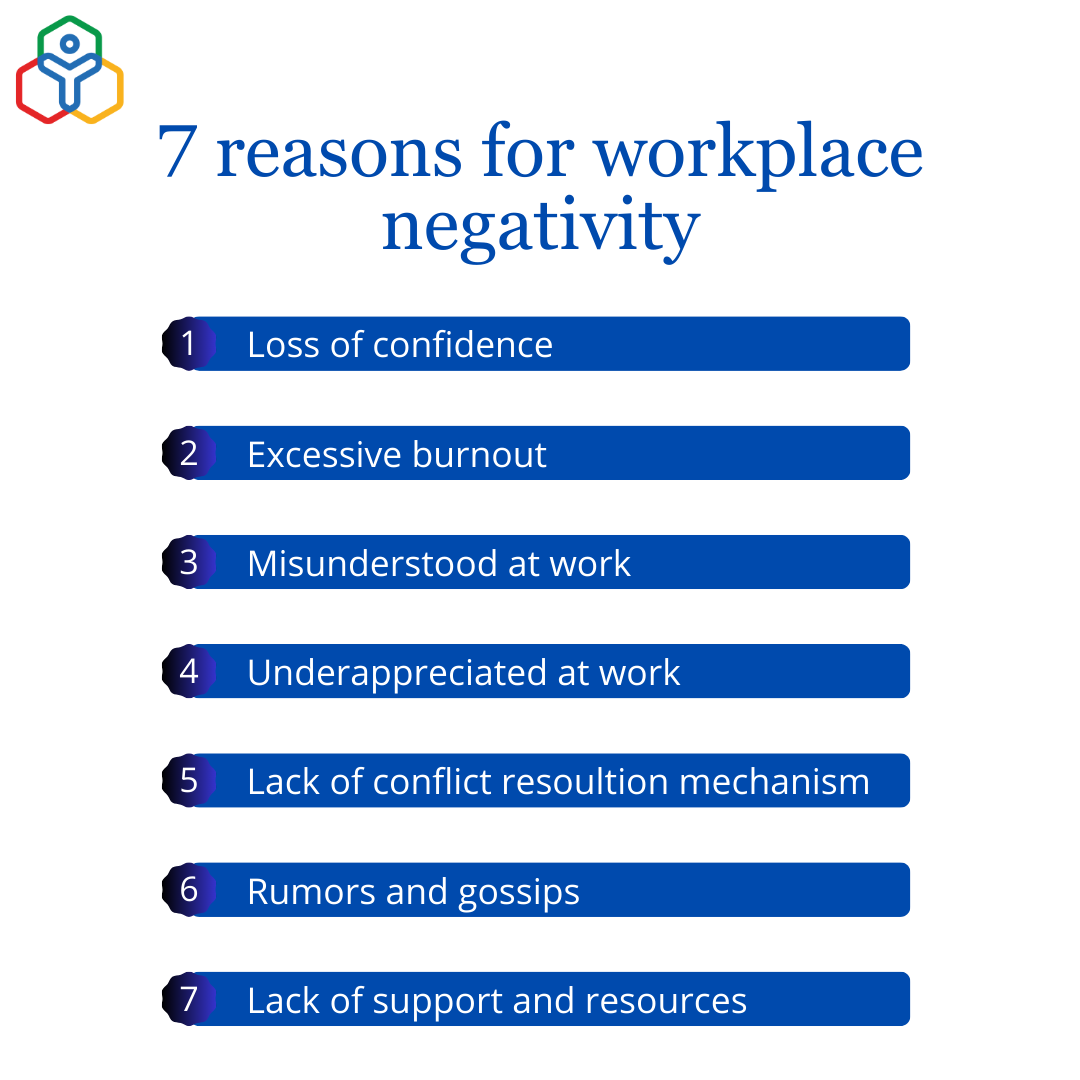- HOME
- HR insights
- 12 tips for minimizing workplace negativity
12 tips for minimizing workplace negativity
- Last Updated : March 25, 2024
- 17.4K Views
- 6 Min Read

As an HR manager, it’s important to pay attention to workplace negativity, as it can threaten the success of your organization. It affects employee morale, and more time and energy ends up spent on unnecessary negativity rather than productive work. Your employees may become hesitant to take on new roles and responsibilities, or their creativity and innovative capacity could suffer. If they can’t think of new ways to reach organizational goals, the company’s growth may take a hit. Negativity causes heavy losses to organizations and deteriorates workplace relationships. So what can you do?

The first step to minimizing workplace negativity is to identify a root cause. For instance, check in with your employees to see if they are feeling:
– A loss of confidence or autonomy
– Burnt out due to excessive work or strict deadlines
– Misunderstood or unheard in the workplace
– Unappreciated, unrecognized, or underpaid
– Unable to resolve disagreements with peers
– Negative as a result of rumors or gossip
– Motivated but lacking resources or support
Once you know the underlying reason for workplace negativity in your organization, you can work to reduce it. Here are 12 tips to help get you started:
1. Identify the cause
We went over common causes of workplace negativity, but how do you know which one is affecting your organization? There may be legitimate reasons to address, and blaming employees for their negative behavior won’t help. Observation is the key to identifying the cause of workplace negativity. Observe employee interactions and understand their perception of the organization. Strive to receive consistent feedback from your employees.
2. Create a positive work culture
It is important to develop a positive culture at your workplace to prevent negativity. A positive work culture reduces stress and enhances the happiness and productivity of your employees. When the workplace is positive, your employees’ commitment to the organization increases and turnover is reduced. The following ideas can help you to create a positive work environment:
Recognize your employees’ hard work
Motivate teams with incentives
Treat everyone with respect
Organize fun activities regularly
Promote communication and collaboration
3. Look out for signs of boredom
Boredom at work is one of the serious issues that can lead to negativity, since bored employees tend to have an idle mind. Due to the lack of motivation, bored employees may not have the will to do anything productive. According to a recent study by OnePoll, almost 46% of employees state that they get bored during at least three days of their work week. That's why it's super important to keep your employees engaged and motivated. Here's what can help you keep boredom at bay:
Encourage managers to assign key tasks and work items that challenge their team's abilities.
Revamp your workspace with interesting decor and productive gadgets to keep everyone motivated.
Encourage managers to keep reiterating how their team's work contributes to the larger purpose.
Be sure to invest in training and development programs that help employees learn new skills.
Keep looking for new ways to spark creativity, innovation, and new ideas among employees.
4. Hire candidates with a positive mindset
If having a positive company culture is one of your organization's core values, look out for candidates with a positive attitude while hiring. Employees who have a positive attitude towards work often radiate enthusiasm and optimism, which can inspire their co-workers and thereby boost morale significantly. There'll be mutual respect and desire to collaborate among employees with a positive mindset, which can foster a wonderful work environment that is free from negativity. Here's how you can hire candidates with a positive mindset:
Mention your expectations explicitly in your job descriptions.
Look for cues when you meet them in person during the interviews.
Use personality tests to assess their attitude.
Ask for references to understand your candidates better.
5. Encourage open communication
Pay attention to the opinions and ideas your employees have to ensure that they feel comfortable in their work environment. Give them a voice in the organization. Your employees will feel more valued and develop a more optimistic outlook on the company and their growth within it. Some ways to encourage open communication in an organization are:
Evaluate the current communication strategy in your organization
Put an end to one-way communication
Implement an open door policy
Encourage your employees to provide feedback
Recognize and reward this feedback
6. Trust your employees
Develop a sense of trust between and with your employees. When your organization doesn’t trust its employees, it can be very obvious. This can lead to lower motivation, and employees may feel unable or unwilling to use their full potential. Here are some steps to foster trust between management and employees:
Keep your employees informed about important decisions
Encourage integrity and ethical behavior in your organization
Pay attention to your employees’ interests
Implement training opportunities
Provide credit to your employees when they succeed
7. Treat all employees equally
Favoritism can cause a loss of motivation and build a feeling of resentment in your employees. As a result, employee loyalty lessens, and a negative attitude towards the organization develops. As an HR manager, it’s your duty to prevent favoritism and ensure that work policies are followed by all the employees. The following ideas can help you to prevent favoritism:
Pay close attention to how you communicate with your employees
Ensure that the mode of evaluation is the same for all employees
Avoid spending too much time with a particular employee
Conduct regular meetings with all employees
Implement a process that allows employees to report bias
Provide proper reasons for every decision involving employees
8. Recognize hard work
Negativity develops when your employees’ efforts go unrecognized. It creates a sense of aimlessness. With the right feedback, rewards, or incentives, you can improve employee morale, and your teams will feel more valued at work. This prevents negativity and motivates them to work harder to achieve organizational goals.
9. Create a culture of growth
When employees feel that their career growth has become stagnant, their motivation to work lowers and negativity may creep in. Establish a culture of growth in your organization by providing training programs. Leadership, soft skills, managerial, and technical skills development are just some of the many training programs that can be introduced in your organization. When employees are satisfied with their career advancement, they are more likely to develop a positive mindset and share that positivity with their peers. Here are some tips that can help you design a proper employee training program:
Ask your employees for suggestions before implementing a training program
Ensure that the training opportunities are consistent with your company goals
Use training methods that are relevant to your industry
Let the experts in your firm handle the training sessions
Evaluate the effectiveness of the programs with feedback
10. Be transparent
Lack of transparency causes your employees to lose their trust in the organization. Provide employees with information about your organization and any updates that are going on within. This not only helps employees feel valued, but it also allows them the opportunity to come up with solutions in case of problems. Here’s how you can develop a transparent work environment:
Be transparent about employee job responsibilities
Let your employees know about the profits and losses in your organization
Create a feeling of inclusiveness in your organization
Develop a habit of consistent communication within your organization
Receive feedback from employees about important decisions and implement their best ideas.
11. Understand your employees’ needs
As an HR manager, you have to be considerate toward employee needs and issues. Help them overcome their professional struggles. Ignoring their problems and making them work continuously can reduce their motivation and make them lose focus. With the following ideas, you can better understand your employee needs:
Converse with your employees on a regular basis
Encourage feedback
Work with them to identify solutions
Evaluate employee engagement and experience
Review the work environment to identify any issues
12. Lend a non-judgmental ear
Communicate with any employees who appear depressed or unmotivated at work. Pay close attention to their side of the story. Try to ask questions to discover the reason for their negative behavior. Suggest ways to overcome negativity, and motivate them to stay positive at work.
Workplace negativity is a major issue that can cause severe financial consequences to your organization. It can decrease employee morale and drain your employees’ energy. Dealing with unmotivated and unhappy employees can cause a lot of stress, and the negativity gradually spreads from one employee to another. With these tips, we hope to help you prevent this negativity and build a happy, productive, and positive work environment.
 Tarika
TarikaContent Specialist at Zoho People


